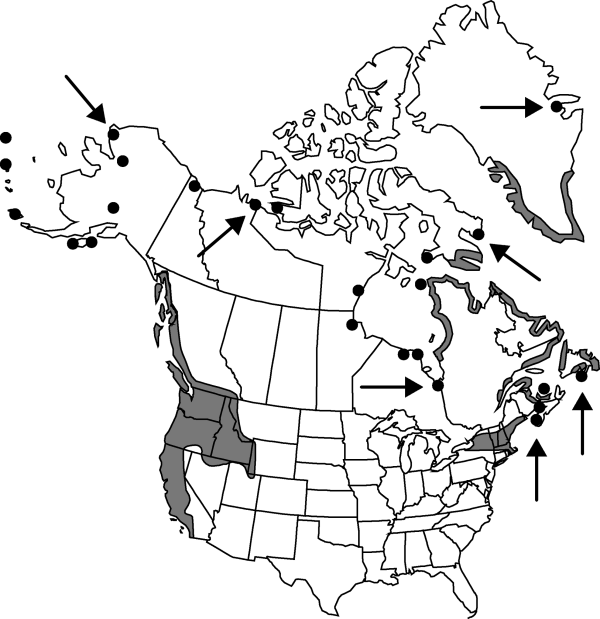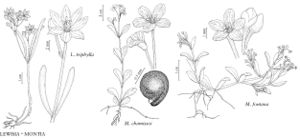Difference between revisions of "Montia fontana"
Sp. Pl. 1: 87. 1753.
FNA>Volume Importer |
imported>Volume Importer |
||
| (5 intermediate revisions by 2 users not shown) | |||
| Line 8: | Line 8: | ||
}} | }} | ||
|common_names=Water blinks | |common_names=Water blinks | ||
| + | |special_status={{Treatment/ID/Special_status | ||
| + | |code=F | ||
| + | |label=Illustrated | ||
| + | }} | ||
|basionyms= | |basionyms= | ||
|synonyms={{Treatment/ID/Synonym | |synonyms={{Treatment/ID/Synonym | ||
|name=Claytonia hallii | |name=Claytonia hallii | ||
|authority=A. Gray | |authority=A. Gray | ||
| + | |rank=species | ||
}} {{Treatment/ID/Synonym | }} {{Treatment/ID/Synonym | ||
|name=Montia clara | |name=Montia clara | ||
|authority=Ö. Nilsson | |authority=Ö. Nilsson | ||
| + | |rank=species | ||
}} {{Treatment/ID/Synonym | }} {{Treatment/ID/Synonym | ||
|name=Montia funstonii | |name=Montia funstonii | ||
|authority=Rydberg | |authority=Rydberg | ||
| + | |rank=species | ||
}} {{Treatment/ID/Synonym | }} {{Treatment/ID/Synonym | ||
|name=Montia hallii | |name=Montia hallii | ||
|authority=(A. Gray) Greene | |authority=(A. Gray) Greene | ||
| + | |rank=species | ||
}} {{Treatment/ID/Synonym | }} {{Treatment/ID/Synonym | ||
|name=Montia minor | |name=Montia minor | ||
|authority=C. C. Gmelin | |authority=C. C. Gmelin | ||
| + | |rank=species | ||
}} | }} | ||
|hierarchy=Portulacaceae;Montia;Montia fontana | |hierarchy=Portulacaceae;Montia;Montia fontana | ||
| Line 54: | Line 63: | ||
-->{{#Taxon: | -->{{#Taxon: | ||
name=Montia fontana | name=Montia fontana | ||
| − | |||
|authority=Linnaeus | |authority=Linnaeus | ||
|rank=species | |rank=species | ||
| Line 68: | Line 76: | ||
|publication title=Sp. Pl. | |publication title=Sp. Pl. | ||
|publication year=1753 | |publication year=1753 | ||
| − | |special status= | + | |special status=Illustrated |
| − | |source xml=https:// | + | |source xml=https://bitbucket.org/aafc-mbb/fna-data-curation/src/2e0870ddd59836b60bcf96646a41e87ea5a5943a/coarse_grained_fna_xml/V4/V4_989.xml |
|genus=Montia | |genus=Montia | ||
|species=Montia fontana | |species=Montia fontana | ||
Latest revision as of 22:02, 5 November 2020
Plants annual or biennial, never bulbiferous. Stems prostrate or decumbent, 1–30 cm, freely rooting at nodes, forming mats. Leaves opposite, sessile; blade oblanceolate to rhombic, 2–20 × 0.5–10 mm. Inflorescences leafy. Flowers 1–8, slightly bilateral; sepals 1–1.5 mm; petals 5, connate proximally, white, unequal, 1–2 mm; stamens 3, anther pink or yellow. Seeds 0.7–1.2 mm, tuberculate; elaiosome present. 2n = 20, 40.
Phenology: Flowering spring.
Habitat: Pools, springs, meadows, other wet or moist places
Elevation: 0-3700 m
Distribution

Greenland, St. Pierre and Miquelon, B.C., Man., N.B., Nfld. and Labr., N.S., Nunavut, N.W.T., Ont., P.E.I., Que., Yukon, Alaska, Calif., Idaho, Maine, Mass., Mont., Nev., N.H., N.Y., Oreg., Utah, Vt., Wash., Wyo., Central America, South America, Europe, Asia, Africa, Arctic regions.
Discussion
Montia fontana displays a multitude of forms varying in stature, leaf shape, and seed size. Segregate species, varieties, and subspecies have been named. Based on my study of worldwide collections of the species, much variation in M. fontana is attributable to phenotypic differentiation of ramets produced by local environmental conditions and unrelated to genetic variation. Until macromolecular or other studies shed light on the variation in M. fontana, it seems pointless to recognize infraspecific taxa or segregate species.
